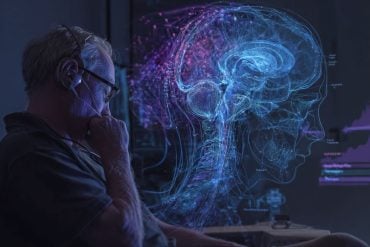Summary: A new study illuminated a part of the “dark genome,” specifically focusing on LINE-1, a genetic element linked to various diseases and aging.
Researchers have provided the first high-resolution images and structural details of LINE-1, an “ancient genetic parasite” with about 100 active copies in each person. This research, involving international collaboration, reveals LINE-1’s mechanism of integrating DNA into the human genome and its correlation with diseases like cancer and neurodegeneration.
The study’s findings offer a foundation for potential treatments targeting this retrotransposon.
Key Facts:
- LINE-1 retrotransposons, involved in various diseases, function by integrating DNA into the genome.
- The study provides the first detailed images and structural insights into LINE-1.
- This research paves the way for developing treatments targeting LINE-1 related diseases.
Source: University of Alberta
Research published today in Nature sheds light on a small part of the so-called “dark genome” — the 98 percent of the human genome whose biological function is largely not known.
In the study, an international multidisciplinary team reported the first high-resolution images and structural details of a genetic element known as LINE-1, which inserts itself into the human genome and is implicated in diseases such as cancer, autoimmune disorders and neurodegeneration, and even aging. The work provides a target for potential new treatments moving forward.

LINE-1 is described as an “ancient genetic parasite” with about 100 potentially active copies in each person. LINE-1 activity is often correlated with disease. Unlike DNA, which makes RNA and then proteins, retrotransposons like LINE-1 work backwards, making DNA from RNA and then inserting it into the genome.
“Retrotransposons are often referred to as ‘jumping genes’ that insert themselves into our chromosomes with a copy-and-paste mechanism,” explains Matthias Götte, professor and chair of the Department of Medical Microbiology and Immunology at the University of Alberta and one of the eight co-corresponding authors.
“For this paper, we discovered the essential steps in this process, which could then lead us to ways to inhibit the enzyme and eventually treat those diseases.”
The team included researchers from institutions in the United States and Europe, as well as biotechnology partners. Götte’s lab was the only Canadian contributor to the research, which was led by investigators from Harvard Medical School and biotechnology company ROME Therapeutics.
The researchers say their analyses reveal the inner workings of the molecular machine that has written nearly half of the human genome, and that understanding LINE-1 structure and function is important both in evolution and, increasingly, in human disease.
The Götte lab, including research associate Egor Tchesnokov, provided much of the biochemical data in the paper.
“It was a large team effort with world-class structural biologists,” says Götte. “Effective treatments for important human diseases can only be developed with a very strong scientific foundation.”
About this genetics and neuroscience research news
Author: Ross Neitz
Source: University of Alberta
Contact: Ross Neitz – University of Alberta
Image: The image is credited to Neuroscience News
Original Research: Closed access.
“Structures, functions, and adaptations of the human LINE-1 ORF2 protein” by Matthias Götte et al. Nature
Abstract
Structures, functions, and adaptations of the human LINE-1 ORF2 protein
The LINE-1 (L1) retrotransposon is an ancient genetic parasite that has written around one third of the human genome through a “copy-and-paste” mechanism catalyzed by its multifunctional enzyme, open reading frame 2 protein (ORF2p).
ORF2p reverse transcriptase (RT) and endonuclease activities have been implicated in the pathophysiology of cancer, autoimmunity, and aging, making ORF2p a potential therapeutic target. However, a lack of structural and mechanistic knowledge has hampered efforts to rationally exploit it.
We report structures of the human ORF2p ‘core’ (residues 238-1061, including the RT domain) by X-ray crystallography and cryo-EM in multiple conformational states. Our analyses reveal two novel folded domains, extensive contacts to RNA templates, and associated adaptations that contribute to unique aspects of the L1 replication cycle. Computed integrative structural models of full-length ORF2p show a dynamic closed ring conformation that appears to open during retrotransposition.
We characterize ORF2p RT inhibition and reveal its underlying structural basis. Imaging and biochemistry reveal that non-canonical cytosolic ORF2p RT activity can produce RNA:DNA hybrids, activating innate immune signaling via cGAS/STING and resulting in interferon production.
In contrast to retroviral RTs, L1 RT is efficiently primed by short RNAs and hairpins, which likely explains cytosolic priming. Additional biochemical activities including processivity, DNA-directed polymerization, non-templated base addition, and template switching together allow us to propose an updated L1 insertion model.
Finally, our evolutionary analysis reveals structural conservation between ORF2p and other RNA- and DNA-dependent polymerases. We therefore provide key mechanistic insights into L1 polymerization and insertion, shed light on L1 evolutionary history, and enable rational drug development targeting L1.






